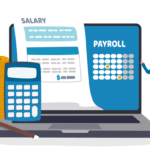Your company’s culture, mission, and impact help you recruit and retain your industry’s top talent. But the importance of a strong compensation and benefits package can’t be overlooked, either. In fact, according to a recent Gallup poll revealing what employees want most in their next job, “greater work-life balance and better personal wellbeing” was second on employees’ list, while “a significant increase in income or benefits” was still first.
Highlighting the value of the benefits you offer to your employees can help them understand how much they are worth to the company, even beyond the flat number of their salary. Outlining the true significance of their comprehensive compensation package begins by parsing out the distinction between total employee compensation and total job benefits. Understanding the difference can be tricky, but the employee benefits experts at Benely are here to help. Read on to learn more!
The Difference between Compensation and Benefits:
“Compensation” refers to everything your employees receive in return for their hard work that is part of their income and can directly translate to cash. Compensation broadly includes an employee’s pay, whether in the form of an annual salary or an hourly wage; incentives like bonuses or other cash rewards received for hitting a goal; equity in your company; and stock options.
Benefits, on the other hand, encompass the items your employees earn that don’t directly translate into cash as a portion of their income. The U.S. Department of Labor’s Bureau of Labor Statistics defines benefits as “non-wage compensation provided to employees.”
If you need a quick way to answer the question of whether an item is part of the employee’s compensation or is a benefit, ask, “does the employee pay taxes on this item?” If the employee has to pay taxes on the item, it’s likely part of their compensation, and isn’t a benefit.
What are Total Benefits?
The U.S. Department of Labor groups benefits into five categories:
- paid leave;
- supplementary pay (premium pay for overtime and work on holidays and weekends, shift differentials, and nonproduction bonuses);
- retirement (defined benefit and defined contribution plans);
- insurance;
- and legally required benefits (Social Security and Medicare, Federal and State unemployment insurance taxes, and workers’ compensation).
In plain terms, benefits include PTO, vacation and sick days, personal and bereavement leave; employer-paid portions of health, dental, and vision insurance; life and disability insurance; retirement benefits like 401(k) / 403(b) and pension plans; day care and tuition assistance; educational benefits; opportunities for career advancement; and relocation expenses.
Benefits are often almost as important to your team as their salary expectations. In fact, a 2018 surveyrevealed that 78% of employees reported being more likely to stay with an employer because of their benefits. What’s more, an Aflac report indicates that about half of employees will start looking for a new job within 12 months if they are not satisfied with the benefits they’re being offered. And as any Human Resources department knows, the negative implications of turnover are huge – and expensive. An analysis published in the Journal of Applied Psychology considering turnover at more than 300,000 organizations and departments found “the relationship between turnover rates and organizational performance is significant and negative.”
The higher-level the employee, the more costly they are to replace. Some companies indicate that the total cost associated with turnover in the role of a specialized employee can cost up to 400 percent, or four times the cost of the employee’s annual salary. Broken down, the total cost of turnover can include:
- the direct cost of hiring a replacement for your employee’s role, including the job advertisement, the interview and screening process, and the hiring process
- the cost of the time and resources devoted to onboarding a new employee, including training time, the adjustment period, and time spent by their managers
- the cost of the lost productivity and errors made during the employee’s learning curve. For specialized employees, learning the job well enough to be fully productive could take months.
Statistics, show, however, that a solution may be found in the provision of a comprehensive total benefits package. Your Human Resources department can take it one step further by breaking down the real value of employees’ total benefits, too.
How Total Job Benefits and Total Employee Compensation Differ:
In short, total compensation includes total job benefits. An employee’s total compensation equals the value of an employee’s compensation, plus the value of the employee’s total benefits. Looking at a compensation package holistically involves counting the value of the benefits provided to the employee as well as their flat salary amount.
How do Employee Benefits Affect Total Employment Compensation?
Understanding how total job benefits play into an employee’s total compensation is a powerful tool for recruitment and retention of talent. Often, an employee or potential job candidate only really quantifies their payment in terms of their base salary, plus any bonuses they expect or hope to receive. Factoring in the monetary value of their total benefits, however, is complicated – and it’s easy to overlook.
Employers can outline the value of their total compensation packages by placing a monetary value on their benefits package. A breakdown of what goes into an employee’s total compensation can go a long way in helping an employee understand their value to the company, and see what they’re “really” getting paid.
How to Determine Total Employee Compensation:
Calculating total employee compensation is a bit of a math problem, but going through the process can pay off exponentially once employees see the real value placed on their time and commitment. To make the calculation easier, you can start by subdividing the different aspects of an employee’s total compensation package (including benefits!) and breaking down the monetary value each category adds.
- Base pay: How much is this employee’s base pay? In other words, how much will they get paid for simply being a part of the company? Many employees are bonused based on their performance, so they’ll receive more or less money depending on whether they’ve hit certain goals or exceeded expectations. Start by jotting down the employee’s pay assuming they do not meet any targets for added bonus pay.
- Bonuses, incentives, and reward pay: Next, consider the amount of money an employee could make over and beyond their base pay in the form of bonuses, incentives, or rewards. You can express this amount in several ways, including as an “up to $X amount,” or as an “average of $X amount” based on the aggregate performance and incentives provided to employees in the same or similar roles.
- The value of time off: You can determine the value of PTO, sick leave, vacation days, or other allotted time off by following this process: calculate the amount of money each work day represents as a portion of the employee’s base pay. For example, if an employee makes $50,000 a year and there are 260 working days in a year, the employee earns roughly $190.00 per day in base pay. Each guaranteed day of PTO, leave, or vacation amounts to $190. So, for example, if your company offers two weeks of PTO, the value of PTO for that employee would be $190 times 10, or $1,900. An additional two weeks of sick leave, added to the value of PTO, would amount to $3,800 per year. That’s a pretty impressive figure to highlight in your recruitment materials!
- The value of insurance benefits: If your organization pays for portions of its employees’ insurance benefits, including health, dental, vision, life, or disability, it’s important to emphasize the amount you are covering when talking about the employee’s total compensation package. For employees for whom the provision of medical insurance is mandated by the Affordable Care Act, you can leave that figure out – if it’s required that your organization covers it, it may be the best practice to leave it out of compensation package discussions. However, dental and vision benefits are never required by the ACA, so if you include the provision of these benefits, be sure to highlight their worth.
- Miscellaneous: Do you provide on-site day care, tuition assistance, or relocation assistance? If so, make sure to quantify how much you spend per employee, whether in terms of a maximum allowed amount annually, or on average. While they may seem like fringe benefits to employees, your carefully curated benefits package includes a lot of costs that can really add up. For example, according to Clutch, companies who subsidize just half the cost of childcare for an employee with two children under the age of 5 will spend around $10,000 each year per employee. With only 6% of companies offering child care subsidization, the tradeoff here could be huge. Tuition assistance is another costly benefit worth highlighting. According to Quantic.edu, employers offering tuition assistance pay an average of $5,250 for undergraduate education and $10,500 for graduate degrees.
Average Cost of Providing Health Insurance to Employees: Single and Family
Doubting the power of emphasizing the total benefits cost to your employees? Consider this: According to research published by the Kaiser Family Foundation in 2019 as part of their Employer Health Benefits Survey, a standard company-provided traditional health insurance policy costs $7,470 a year for coverage for a single employee. Employers pay an average of 83 percent of the premium, totaling an impressive $6,200 per year. Single employees, on the other hand, pay only an average of 17 percent of their medical insurance costs, totaling just $1,270 a year in comparison. The amount covered by employers is obviously even higher for employees with families and dependents. For family coverage, the average standard traditional health insurance policy costs a total of $21,342. Employers contribute an average of 73 percent of that, for a coverage amount of $15,579, while employees pay the remaining 27 percent ($5,763) each year.
The costs are still high for point of service health plans, and high deductible health plans, so if your company doesn’t offer “traditional” full coverage medical insurance, don’t let that fact deter you from calculating your contribution costs and representing them during compensation package discussions. The Kaiser Family Foundation reports that employers pay similar amounts for these plans, including:
- $6,112 of the average total cost ($7,185) of single employees’ point of service health plans;
- $12,894 of the average total cost ($19,838) of family point of service health plans;
- $1,017 of the average total cost ($6,412) of single employees’ high deductible health plans; and
- $14,114 of the average total cost ($18,980) of family high deductible health plans.
Emphasizing Your Total Benefits Package During the Recruitment Stage
Getting the value of your total compensation package (including benefits) can be difficult, especially when employees tend to only see their base pay. If you decide to advertise base pay as a dollar figure in your job posting advertising, consider discussing benefits offering immediately after, without skipping to the next subheading. Incorporating benefits information or highlighting a few of your most important or unique offerings can help highlight the value of these compensation items. In a blurb about the company’s culture, you can, for example, highlight the importance and availability of mental health and wellness programs at your firm. The key is to put your best foot forward and attract employees who will value and take advantage of what you can offer, making the most of your benefit dollars.
At the new hire stage, information about benefits can seem overwhelming to an incoming employee who is absorbing a lot of other data at one time. During the employee’s informational interview, consider having a representative from Human Resources discuss the available benefits options the employee can select from. It also creates a perfect time and space for an employee to ask questions and receive individual support.
Get Comprehensive Assistance Putting Together Your Benefits Package at Benely.
From time to time, we can all use a little help from the experts. That’s where Benely comes in. As experts in employee benefits, Benely knows that a great compensation package, including stellar benefits, lets your company recruit and retain the talent to help you thrive. Benely is here to help revisit or revamp your total compensation package simply, seamlessly, and happily. Contact Benely or request a free demo today.






